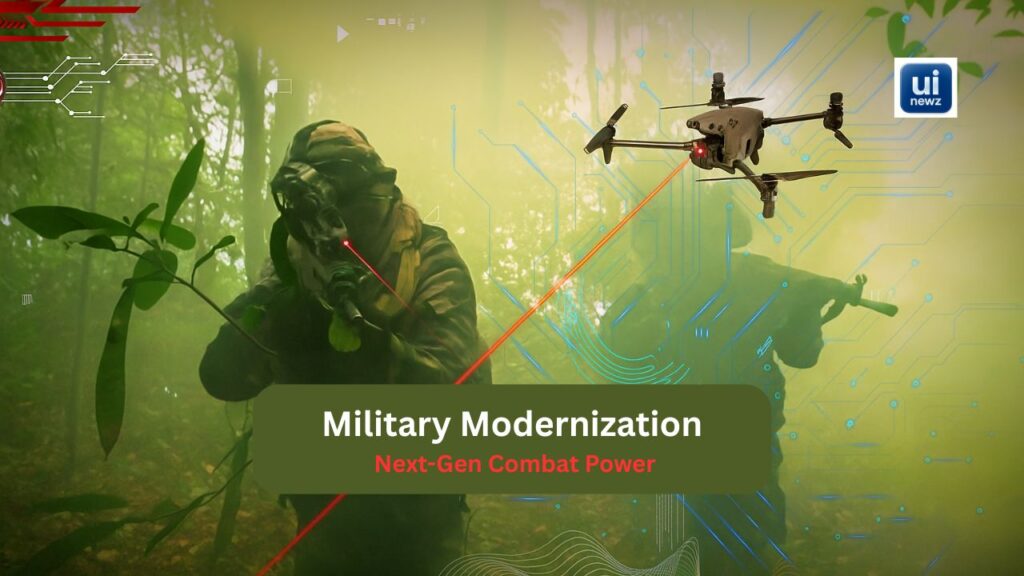India’s security landscape is shaped by two nuclear-armed neighbors, persistent cross-border terrorism, and evolving non-traditional threats such as cyber warfare and space militarization. To meet these challenges, the Indian Armed Forces—the Army, Navy, and Air Force—are undergoing a comprehensive modernization drive. This involves upgrading equipment, enhancing indigenous manufacturing, restructuring forces, and embracing emerging technologies. India’s goal is to build a future-ready, self-reliant military capable of safeguarding national interests while projecting power in the region.
Drivers of Modernization
- Geopolitical Pressures: India faces a volatile neighborhood with China’s assertiveness along the Line of Actual Control (LAC) and Pakistan’s support for cross-border terrorism.
- Changing Nature of Warfare: Hybrid threats, cyber intrusions, and drone warfare demand capabilities beyond conventional firepower.
- Technological Gap: To compete with global powers, India must bridge gaps in precision weaponry, air defense, space assets, and AI-driven systems.
- Self-Reliance Push: The “Atmanirbhar Bharat” initiative emphasizes reducing dependence on imports by boosting indigenous defence production.
Indian Army Modernization
The Indian Army, the world’s second-largest standing force, is transitioning from manpower-heavy to technology-intensive:
- Infantry Enhancements: Procurement of modern rifles (Sig Sauer, AK-203), bulletproof gear, and night-vision systems to increase combat efficiency.
- Artillery Modernization: Induction of the Dhanush howitzer, K9 Vajra-T tracked self-propelled guns, and advanced rocket systems like Pinaka.
- Armored Corps Upgrades: Plans for a next-generation Main Battle Tank to replace aging T-72s, alongside modernization of the Arjun Mk-1A.
- Integrated Battle Groups (IBGs): Reorganized, agile formations designed for swift, high-intensity operations along borders.
Indian Navy Modernization
As a maritime power with Indo-Pacific ambitions, India’s Navy is focusing on blue-water capabilities:
- Aircraft Carriers: INS Vikrant’s commissioning in 2022 marked a milestone in indigenous shipbuilding. Discussions continue on a second Indigenous Aircraft Carrier (IAC-2).
- Submarine Fleet: The Navy is inducting Kalvari-class Scorpene submarines and planning nuclear-powered attack submarines (SSNs).
- Surface Combatants: Advanced destroyers like the Visakhapatnam-class and frigates under Project 17A bolster maritime strike power.
- Naval Aviation: Acquisition of MH-60R helicopters and drones strengthens surveillance and anti-submarine warfare.
Indian Air Force Modernization
Air dominance is critical for deterrence and rapid power projection:
- Rafale Induction: The French-origin fighter provides cutting-edge capabilities in precision strike, electronic warfare, and nuclear delivery.
- Indigenous Fighters: The Tejas Light Combat Aircraft (LCA) and upcoming Advanced Medium Combat Aircraft (AMCA) highlight India’s drive for indigenous airpower.
- Air Defence Systems: Deployment of S-400 Triumf systems enhances India’s layered missile defence shield.
- Drone Warfare: Procurement of Heron UAVs and plans for armed drones like MQ-9B SeaGuardian improve reconnaissance and precision strike capability.
Tri-Service Integration and Reforms
Modernization also involves institutional reforms:
- Chief of Defence Staff (CDS): Established to ensure jointness in operations, procurement, and doctrine.
- Theatre Commands: Ongoing efforts to create unified theatre commands for efficient coordination among the Army, Navy, and Air Force.
- Defence Budget Priorities: The 2024–25 budget emphasized capital expenditure on modernization, with higher allocations for indigenous procurement.
Challenges in Military Modernization
- Budgetary Constraints: Despite increases, allocations are often stretched between pensions, salaries, and capital acquisitions.
- Slow Procurement Processes: Bureaucratic delays hamper timely induction of critical systems.
- Technology Dependence: High reliance on foreign systems for engines, avionics, and sensors remains a weakness.
- Human Resource Transformation: Shifting from manpower-intensive to technology-centric warfare requires cultural and structural changes.
The Road Ahead
- Boosting Indigenous Defence: Accelerating the Atmanirbhar Bharat initiative through public-private collaboration.
- Focus on Emerging Tech: Greater investment in AI, quantum computing, cyber resilience, and space-based assets.
- Regional Partnerships: Defence cooperation with the U.S., France, Israel, and Quad countries to ensure technology access and operational synergy.
- Infrastructure Development: Enhancing border infrastructure, airfields, and logistics to support rapid mobilization.
Conclusion
India’s military modernization is not merely about acquiring advanced platforms—it is about transforming the armed forces into a cohesive, agile, and technologically superior force. The process is ambitious and challenging but essential to secure India’s sovereignty, deter adversaries, and assert its role as a responsible global power.
A future-ready Indian military, built on the pillars of self-reliance, jointness, and technology, will not only safeguard national interests but also contribute to peace and stability in an increasingly uncertain world.

